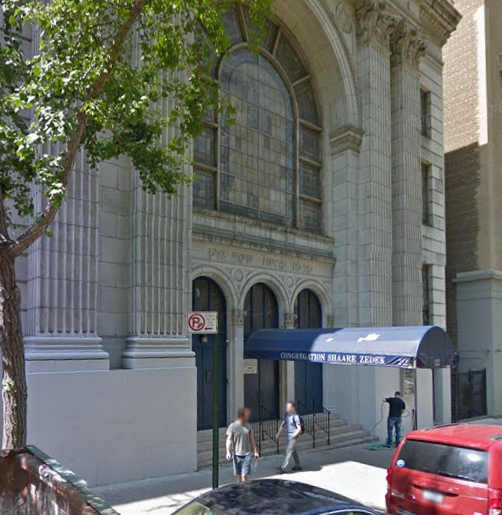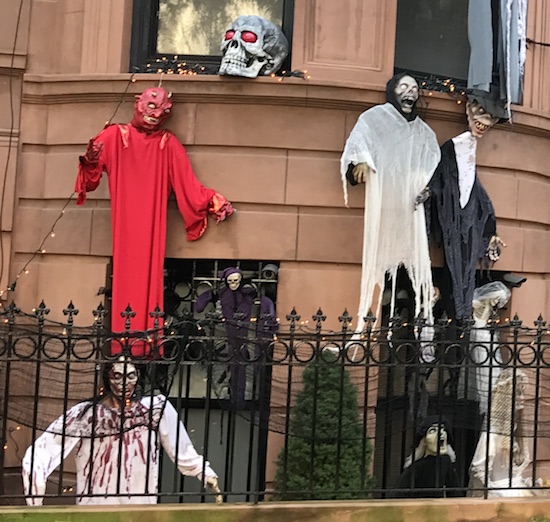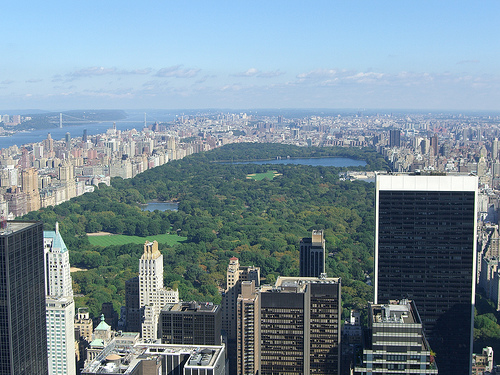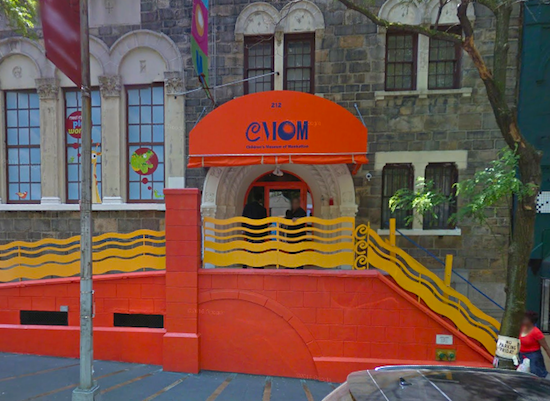Congregation Shaare Zedek built its current synagogue at 212 West 93rd Street in 1923. Now, it could be headed for the wrecking ball.
The congregation leaders said at a meeting last month that they need to redevelop their site to keep up with expenses. They’re planning to demolish the building and construct an apartment building on the site with a synagogue inside.
There’s been considerable community opposition already.
On Thursday night, they’ll be discussing that possibility at a community board meeting. The agenda is below. The meeting is at 250 West 87th Street.
Update: This meeting is for informational purposes only, CB7 manager Penny Ryan noted in a phone call Thursday afternoon. No vote will be taken, and the meeting will be led by neighbors concerned about the demolition, not the synagogue itself (the synagogue will send a rep, who may discuss the plans).
Preservation Committee, Jay Adolf and Gabrielle Palitz, Co-Chairpersons
Thursday, October 13, 6:30 PM
1. 221 West 79th Street, d/b/a Voila Chocolate (Broadway – Amsterdam Avenue.) Application to the Landmarks Preservation Commission for a window replacement on the second floor.
2. 513 Columbus Avenue, d/b/a Osteria Cotta Restaurant (West 85th Street.) Application to the Landmarks Preservation Commission for legalization of Store front.
3. 144 West 88th Street (Columbus – Amsterdam Avenues.) Application to the Landmarks Preservation Commission for a front façade renovation.
4. 44 West 95th Street (Columbus Avenue – Central Park West.) Application to the Landmarks Preservation Commission for a rear yard addition on three floors, rooftop addition, façade restoration, and new windows.
5. 212 West 93rd Street, Shaare Zedek Synagogue. Informational presentation on the proposed demolition of the building and construction of a new building that will include a new synagogue.
Directed by the City Charter mandate that Community Boards review matters prior to consideration by the Landmarks Preservation Commission, the Preservation Committee reviews the “appropriateness” of proposed changes to individually designated landmarks as well as to properties listed within the Upper West Side’s Historic Districts.










new luxury housing right across the street from the projects….love it
Sixty years ago there were two million Jews in NYC, 5% of whom were orthodox. Now there are one million, and 35% are orthodox.
Obviously, there are not enough conservative and reform Jews left to support the infrastructure that exists, inclusive of this conservative shul. So a decision to “preserve” this landmark is, in fact, a decision to condemn it to slow deterioration and death, and a possible danger to the community.
How many derelict churches and synagogues do we need on the UWS?
Interesting stats. Could you cite a source for them? (I’m not disputing the stats, just interested in seeing a source.)
Note that among Orthodox-identified Jews, actual levels of religious observance sixty years ago were considerably lower than they are today. From what I have heard, it was not uncommon in those days to find entire congregations that were nominally Orthodox but which had few, if any, members who were actually Sabbath-observant (at least according to Orthodox standards).
I think the issue is that people no longer choose to affiliate with a specific shul/pay dues/find their sense of community at the shul. We all had that growing up but that might be part of the issue.
I’m not sure I understand you. Do you mean that even those Jews who attend synagogue at least semi-regularly are less likely to belong-to (and therefore support) any particular one?
@Paul — I agree with your points 100%. This is not the biggest deal to me, if you want to see a great looking Manhattan shul which was restored beautifully, go to the Eldgridge Street Synagogue (also a museum). Byebye Shaare Zedek.
If congregations and donations are dwindling the synagogue needs to do something to survive.
Thank the Lord that they were blessed with this valuable piece of property that should ensure their survival.
Hopefully it won’t wind up an empty, deteriorating hulk like the church on 96 and CPW.
Its exterior could be preserved and the interior converted to some other use. Though the charge on 96th and CPW is a great example of how hard that can be.
If the synagogue is planning to build up presumably they have air rights. Maybe they could sell them to preserve the existing building.
Air rights are usually only transferable to a physically adjacent property, so the market is pretty limited.
They are better off moving the congregation somewhere else for a year or two so they can develop their property and come back.
From the description provided, it sounds like the synagogue is looking to stay an active synagogue, so selling the building and converting the interior to some alternate use does not solve their problem, whereas redeveloping the site with a synagogue inside a larger building does.
Selling air rights might be a good alternative for them–if zoning allows for it in that location and if there are any takers. My guess is that there aren’t any takers, however, as I’m sure demolishing their historic facade was not first on their solution list.
Building next door on Amsterdam tried several years ago to purchase the air rights; the congregation turned them down flat.
You only sell off air rights if they aren’t needed; and apparently as the proposed redevelopment of this property includes a 14 story building, they are.
“Charge” means “church”, thanks autocorrect.
Re: ” thanks autocorrect.”
The antidote to autocorrect is Proofreading-Before-Publishing.
As someone once wrote to Dorothy Schiff, then publisher of The New York Post,:
‘Dear Mrs. Schiff, I read your paper every day. I wish your proofreaders also would.’
I’ve noticed that you are quite selective with your corrections. You single-out posters with whom you disagree for public censure, while ignoring those who express views you are favorable toward.
We’re talking about a nearly century-old building. Why can’t the example of the Museum of Natural History be followed? Merge the classic and contemporary through creative and thoughtful architectural design. Augment the old with an addition of residences above. We owe it to future generations to preserve our history. The country is only 240 years old.
The AMNH is working with a blank slate.
Pretty sure that the existing synagogue building wasn’t built to be able to support an additional 10-20 floors.
Thanks Lois.Good suggestion
Does the city even review the stress on infrastructure, i.e.subways w/all the new additions?
City planning keeps track of the population and resources of the city. We have had unprecedented population growth in recent years, but that doesn’t mean the resources can’t handle it. A new water tunnel and sewage treatment plants were built and put into operation. We are using less water now than we did in the 1990’s. We are still wasting a lot of energy and can do better. Better design an new buildings can help in better utilizing the resources.
https://data.cityofnewyork.us/Environment/Water-Consumption-In-The-New-York-City/ia2d-e54m/data
https://www1.nyc.gov/site/planning/data-maps/nyc-population/current-future-populations.page
https://en.wikipedia.org/wiki/Demographic_history_of_New_York_City
https://blogs.ei.columbia.edu/2015/09/28/how-much-energy-does-nyc-waste/
Well, there’s certainly plenty of room still on the subways… (sarcasm)
The East Side will hopefully have the Second Avenue line running by the end of this year. The West Side needs a new line that uses the larger IND subway. West End Avenue from 59 Street to 96 Street could be a good starting point for the project.
“We have had unprecedented population growth in recent years, but that doesn’t mean the resources can’t handle it.”
i think the issue is more public space, streets and traffic, transportation..
…you know, the things that are deteriorating.
We do need wider sidewalks. Have you walked up Lenox Ave and Adam Clayton Powell Blvd in Harlem? Maybe we need to tear down a few blocks or buildings on the UWS to create more open space. Haussmann had the right idea for Paris.
https://en.wikipedia.org/wiki/Haussmann%27s_renovation_of_Paris
I fail to understand the willingness of people to tear down that which they would NEVER be able to construct themselves.
That facade is an architectural treasure! The Landmarks Preservation Committee should require that the facade be maintained and that any new building fully incorporate it into the new design.
Why are persons second guessing owners of the property?
The congregation has already studied both saving the interior and façade; both would require vast sums to repair/maintain which they do not have.
You can attempt to force owners of property to keep a façade say via landmark status or other tactics but if the thing isn’t structurally sound what is the good of that? Compelling owners/developers of a property to spend money they do not have/drive up costs just to prove a point?
Why didn’t you ask the synagogue for the whole story? It is a rich and compelling one, not the narrow view of some who just don’t want a new building to look at.
If you want to practice real journalism (or is the title “Rag” meant to be serious?) talk to the Congregation to get the full human story.
Full disclosure (also an aspect of journalism): I’m a member. The members voted 100% — yes, that’s not a typo, 100% to support this project.
Yes, I too am a member and it was a 100% vote. There is no choice financially and also structurally. The building and the congregation cannot survive as it is now. It is sad, but there is no other option. If the choice is between amputating a leg and keep the person alive, most will agree on amputation. I am not exaggerating with my analogy.
I hope the “whole story” includes the community that you’re in.
That’s why we’re sending a reporter to the meeting tonight! Unlike most publications, the Rag previews meetings to allow the community to get involved if they desire. Almost every other publication tells people about meetings only after they’ve occurred. WSR
thanks for this. Please don’t rely only on what is said at the meeting but there is never time to give the complete story. Talk to the leadership in addiition
Hey, I know… let all of the opinionated locals get together enough scratch and buy the building! Then they can all bring their lawn furniture and sit there looking at it while they figure out a way to make the payments for mortgage, taxes and all of the fines the DOB and FDNY pass out on a weekly basis to businesses to justify their existence!
Taxes? Synagogues don’t pay taxes. Religious institutions are so revered, so singular that the rest of us are expected to pay their way. I don’t sound like a cynical atheist, do I?
Religious buildings do not pay taxes because of the 1st Amendment. If Government can tax, it can ban. Imagine a state, say Utah deciding to not have property taxes for the Morman Church, but everyone else is taxed. Or, NY passes a law that assesses property taxes to Religious buildings, but no tax if they agree to perform gay marriages and hire gay priests and teachers. See the problem?
By that logic, it is only a problem if some religions/houses of worship are taxed and not others. If everyone is taxed, then it is a non-issue. Which I am in favor of. Why should everyone else pay property taxes to support religions?
They actually don’t pay taxes mainly because they provide community services that would otherwise have to be organized by local government and paid for by tax $.
There is more to it than that:
https://churchesandtaxes.procon.org/
https://law.justia.com/constitution/us/amendment-01/05-tax-exemptions-of-religious-property.html
https://religionnews.com/2015/08/26/5-reasons-we-should-never-tax-churches-even-if-john-oliver-is-right-commentary/
Long story short while yes, churches like all non-profits provide means to serve the common good, they have the added benefit of USC protections of separation between church and state. Religion is supposed to remain out of politics/governmental affairs, and government vice versa. We know this is not exactly strictly true, but there are limits to say how politically active any church/religious group can be and still maintain their tax exempt status.
Why can’t they incorporate the beautiful architecture of this building like they did for the luxury building on 106st & CPW. Thank goodness someone stepped in to save Grand Central.
So called “saving” of GCT had two parts.
First was Mrs. Kennedy and others who fought Penn-Central in the courts (and won) to prevent the place from being torn down/office tower built on top. However that was only half the battle.
Then as now giving a building landmark status means totally noting if the owners can or will not spend the funds for upkeep. It has then and still happens that building owners simply let the place go to rot and ruin. That is where the second half of the scheme to save GCT came into play.
New York State via the MTA took out a one hundred year lease on the place from Penn-Central. The state via that public authority began pumping hundreds of millions into renovations, maintenance, security, etc… The result is the GCT we see today.
There is talk the state may actually purchase GCT from Penn-Central (yes, that RR company is still around mostly managing the real estate assets/collecting rents).
Yes it’s privately owned – but Penn-Central is long gone. It was renamed in the 90s to a holding company, absorbed into another company – then GCT+tracks were sold to another group in 2006.
Yes, that is correct; should have looked it up. Why am I not surprised a venture capital group is mixed up in it all.
https://en.wikipedia.org/wiki/Penn_Central_Transportation_Company
A beautiful example of historic architecture and innovative design, but not a great modern train station.
https://en.wikipedia.org/wiki/Grand_Central_Terminal
Maybe, maybe not. But GCT is and was streets ahead in terms of function than Penn Station.
One of the main reasons for the constant problems with flows of passengers and other traffic in Penn Station is that it uses stairways to get to and from the boarding platforms. GCT OTOH uses gently inclined slopes which is far better for moving persons (and their luggage/ or goods) to and from the platforms. You see proof of this each and every day on NYC subways where the bottle necks are always around stairs.
The other bits are quibbles; New York Central’s “yards” are under GCT and extend northwards on either side of Park Avenue to about far up as the Waldorf Astoria area. PRR built their yards out in Sunnyside, Queens and a tunnel to move trains there and back.
The entry ramps at GCT are nice but might still be too steep for ADA requirements. Both Penn Station and Grand Central have expanded into long, endless, crowded and complex passageways which are difficult to navigate. The many business promenades make it like walking down a street but without the vehicular traffic, a positive feature. Times Square has greatly improved but Union Square needs more work. The regional transit hubs are probably trying to do too many things. Penn Station still has concourses that serve both NJT and Amtrak at the same time where interaction is not needed. GCT will have a new LIRR terminal that is separate. A new regional hub uptown in Harlem around the 125 street Metro North station might be something to consider.
You can’t save everyone.
People need to wake up and realize that aside from a few faiths or sects (Muslims, Orthodox Jews, etc…) organized religion in the United States is largely following the same pattern in much of Europe; decreasing numbers year after year. We are living in what appears to be an ever increasing secular world.
As such no small amount of real estate is becoming or will become surplus to requirements. Convents, rectories, schools, hospitals, houses of worship… the lot.
If you are going to extend landmark protection to every single religious building in Manhattan/NYC be prepared for a battle.
Real estate is probably the one thing many non-profits count upon as their “piggy-bank” if you will. Start messing around with that and you are going to cause plenty of trouble.
“Start messing around with that and you are going to cause plenty of trouble.”
…are these non-profits “troublemakers” or good neighbors. Maybe there is a better future than we got to do it their way.
Please don’t do this.Even a bank or drugstore would be better!Another high riser means more people on the subway platforms or bway buses.More nannies pushing mega strollers .More airbnb tourists walking three abreast on the streets.More bikes chained to the trees More pizza delivery bike riders on the sidewalks.
More people + nannies + strollers + tourists = a thriving, growing neighborhood. I say bring it on! (But yes, please save the façade and the sanctuary.)
So, basically, nothing will change. A drop in the bucket. If you don’t like dense urban neighborhoods then why live in New York? Honest question.
There is actually a happy alternative for the Shaare Zedek congregation and the historic synagogue.
Romenu, a growing UWS congregation with over 600 families, is very seriously interested in buying the Shaare Zedek building. The Romenu leaders have even approached Shaare Zedek a number of times about doing so, and has made a very credible starting offer.
With the proceeds of such a sale, the much smaller Shaare Zedek congregation could purchases new home, and the historic building could be preserved and continue to be used as a synagogue.
It is a win-win solution.
That is going to have to be one heck of a “credible” offer to get that property.
We’re talking Manhattan real estate here, if a several hundred year old historic hospital can be shuttered and redeveloped, all bets are off.
B.B.
I don’t accept that “all bets are off”.
There is another congregation willing to pay to get the space. There are alternatives to destroying the building and putting up condos.
Why shouldn’t these being considered by a religious institution that, I am sure, doesn’t pray to manon?
If religious institutions prioritize money above all else, then I would agree that “all bets are off”.
How cavalier we seem to be with century old beautiful buildings that are irreplaceable. How is it that European cities have historic monuments that go back frequently to the 13th century, but New York can’t even keep their monuments for 100 years. Destroying our historic footprint is
immoral. The reason synagogues and churches are coming up with these plans is the lure of big money-period. There are resources available to restore historic houses of worship. As for the church on 96th Street-more than half the Congregation who wished to remain there were sold out by their leadership who sold the church and ran. Then a plan to condo it that didn’t come close to meeting city zoning regulations after nearly a year of meetings. The church has had very serious buyers who wish to use it as a museum or a church. The owner is holding out for mega money.
Many European countries “save” historic buildings via generous subsidies from the state. Even then it is usually Americans or other foreigners with some sort of dream/mission of living in a castle or whatever, and deep enough pockets to make it happen.
https://internationalliving.com/2012/01/restore-a-french-historic-home-grants-available/
For the record France like many other European countries does allow major renovations to “historic” buildings if one has enough money and juice to make things happen.
https://content.time.com/time/world/article/0,8599,1928734,00.html
https://www.theguardian.com/world/2009/aug/23/hotel-lambert-paris-france
https://www.theguardian.com/world/2009/aug/23/hotel-lambert-paris-france
This happens because the French government largely realizes there are two choices; allow a building to fall into decay and ruin, or let someone else take on the costs of ownership/restoration.
Yes, France like other European cities has a vast amount of buildings going back centuries. The country and in particular city of Paris was also fortunate in that it was largely spared the large scale bombing during WWII that leveled many other European cities (London, Berlin, etc…).
With all due respect to your comment, I agree. I love that Paris has much respect for their historic buildings and their character. I wish the old Penn Station was never torn down. However, not all of these cases is a money grab. While that might be in some cases, there is usually a backstory that doesn’t always get told (and there certainly is one here). Please hear their backstory before throwing the “greed” word out there.
And that would be great if there was another congregation wanting to occupy the space. Ideal. I doubt that will happen as I’m sure these developers are offering big money.
“It is a win-win solution.”
i hope you are correct.
It may be a win/ not-as-much-money-as-we-could-possibly-get situation.
And they are allowed to sell/demolish but the decrepit church on 86th and Amsterdam is not because…??
Congregation Shaare Zedek and West-Park Presbyterian Church shared or share much in common. An aging and diminishing congregation, dwindling funds and stuck with a vast and aging structure that is falling to bits around them. However the latter was “saved” because Gale Brewer, the City and “Friends of West-Park Presbyterian” got the place landmarked.
For as much good as it has done anyone the place sits shrouded in netting and scaffolding and still is basically falling apart. But hey, the building was saved so that is something anyway.
Frankly, could care less. I would much rather they preserve our dwindling supply of parking garages, that actually serve a real purpose for residents and also generate income and pay taxes.
There are many reasons why these deals occur. Congregation Shaare Zedek is closing in on its 180th birthday in a few months. Despite our age, it is a living, breathing and active synagogue. The community transcends this structure. This is SZ’s fourth building (the first was on the LES on Henry Street), which has served the community well for quite a while. However, the structures we build in the 1920s do not always fit the needs of a community decades later (especially in a competitive neighborhood such as this one). While many are quick to made an attachment a facade (while few of those people have some inside), there is usually a story in the building’s bones and an institution’s annals. SZ wants to continue to cement its deep UWS roots for many years to come and continue to be part of this neighborhood. SZ badly hopes to have that chance. For full disclosure, I am a proud member of Congregation Shaare Zedek.
There are many reasons why these deals occur. Congregation Shaare Zedek is closing in on its 180th birthday in a few months. Despite our age, it is a living, breathing and active synagogue. The community transcends this structure. This is SZ’s fourth building (the first was on the LES on Henry Street), which has served the community well for quite a while. However, the structures we build in the 1920s do not always fit the needs of a community decades later (especially in a competitive neighborhood such as this one). While many are quick to make an attachment a facade (while few of those people have come inside), there is usually a story in the building’s bones and an institution’s annals. SZ wants to continue to cement its deep UWS roots for many years to come and continue to be part of this neighborhood. SZ badly hopes to have that chance. For full disclosure, I am a proud member of Congregation Shaare Zedek.
I love Congregation Shaare Zedek and attend services regularly. It is “heimish,” vibrant, and liturgically traditional while still being proudly egalitarian. That’s hard to find these days. But we are very small and live in a huge building that we can’t afford to maintain. We also inherited responsibility for a cemetery in Queens from several defunct congregations, which is a major drain of our resources. This deal will help us reestablish ourselves on a firmer financial footing and ensure our continued existence on the UWS.
Share Zedek has a long history of financial troubles but the most glaring is its well-covered dereliction of duty concerning its stewardship of Bayside Cemetery in Queens, whose operating fund the congregation misused for years. Whether the fund was misused, improperly diverted to the synagogue, or – as some say – plundered, the congregation’s abysmal stewardship had disastrous and horrifying results.
They congregation’s failure to do any maintenance allowed the cemetery to become so overgrown that none of us could venture even a foot off the walkways to visit the graves of our family members.
The congregation’s failure to provide security or a caretaker left the cemetery exposed to the most heinous of desecrations. Over the years, ghoulish vandals actually broke into mausoleums and bodies were actually taken from their coffins and strewn about the grounds.
Before a single cent of benefit can be reaped by the shul from this transaction, the attorney general should require significant monies to be set aside for the rehabilitation and perpetual care of Bayside.
There are more curret histories written about the Jewish Community in NYC than the the one sited here from the NY Times back in 2002. Apparently, when the Lower East Side was too expensive, Harlem became a lest costly alternative for Jewish families and that area became the hone for more members of the Jewish faith than almost anywhere. Then, there developed a migration to the Upper West Side. And, the other day we read of an annex of the JCC being opened in Harlem. Why? Several thousand members of the Jewish community have settled there. “There is nothing new under the sun.”
https://www.google.com/url?sa=t&source=web&rct=j&url=https://mobile.nytimes.com/2002/06/07/arts/vestiges-of-harlem-s-jewish-past.html&ved=0ahUKEwi95Ni5rtnPAhWHez4KHQZ4AagQFggbMAA&usg=AFQjCNF5GICR9AFAxWulCaDpWiNqfUFkEQ&sig2=jX7BfbgqIjxGgG15bGuKMw
We would like to see the Church on CPW at West 96th Street made into a perforing arts center. The facade, which we understand is Landmarked, can be preserved. The inside we understand was gutted unfortunately. But, the space could surely serve the community as a space nurturing new talents and old masters with proper guidance and well structured support.
Despite the narrative many would have the world believe, Harlem was not built/developed for the African American community solely nor in large part.
Rather as the subway and El trains made their way up the west side developers in the middle to late 1800’s began to first concentrate on the UWS then onto Harlem. They built homes and apartment buildings for white middle and upper class households.
Sadly no small amount of this housing in Harlem was built on speculation so when a series of economic jolts hit (including a depression in 1895) along with other events caused whites to begin fleeing Harlem. Property owners began turning to the two groups often in need of housing but faced discrimination; African Americans and Jews (mostly but not always Easter European).
The Lower East Side along with other Jewish enclaves down town were crowded and well, where what they were. The subways made getting to Harlem rather easy so that was that.
The famous Strivers Row of houses was one of the last hold outs to begin selling to non-whites.
Few know this but around 1900 Harlem had the highest number of Jewish persons outside of Krakow and Lower East Side; that is saying something.
Harlem was overbuilt after the Harlem Line from Grand Central Station allowed the upper class in Midtown Manhattan to spend their summers in the suburbs. The Real Estate Bust of the 1890’s forced property owners to lower prices allowing people not welcome downtown to move to a more affordable Harlem. Many of the properties fell into disrepair and by the 1970’s there were many empty lots. Large swaths were filled in with urban renewal projects. Much of the old Harlem remains and is a shocking contrast to the newer buildings.
Hard to believe today that Strivers Row sunk so low as many of those townhouses became SROs and boarding houses.
Know so many persons straight, gay, New Yorkers, Europeans, etc… all have moved to Harlem in the past ten or so years. Europeans in particular love the area and is often the first place they go house hunting.
Great thing is that so many of the old properties have their original details in whole or part. Sometimes they are buried under a drop ceiling or layers of paint, but that can be fixed.
The facades of the northern portion of Striver’s Row (designed by Stanford White and built around 1890) are nearly completely intact and have suffered little change over the years. If you peek into some of the building lobbies, you might see some of the original townhouse staircases. SRO’s were not uncommon in what we consider historic buildings. The Stuyvesant-Fish house in the East Village was once a rooming house and brothel.
Where’s the Landmark Preservation Committee?!!!
Recent changes to the landmarks laws means the LPC they may or may not be able to render the aid many seem to wish.
IIRC there is a fixed time period to declare a property landmarked. If it isn’t then thing is taken off calendar and cannot be reconsidered (again IIRC) for five years.
Also *IIRC* property owners can now object and that will stop the entire process.